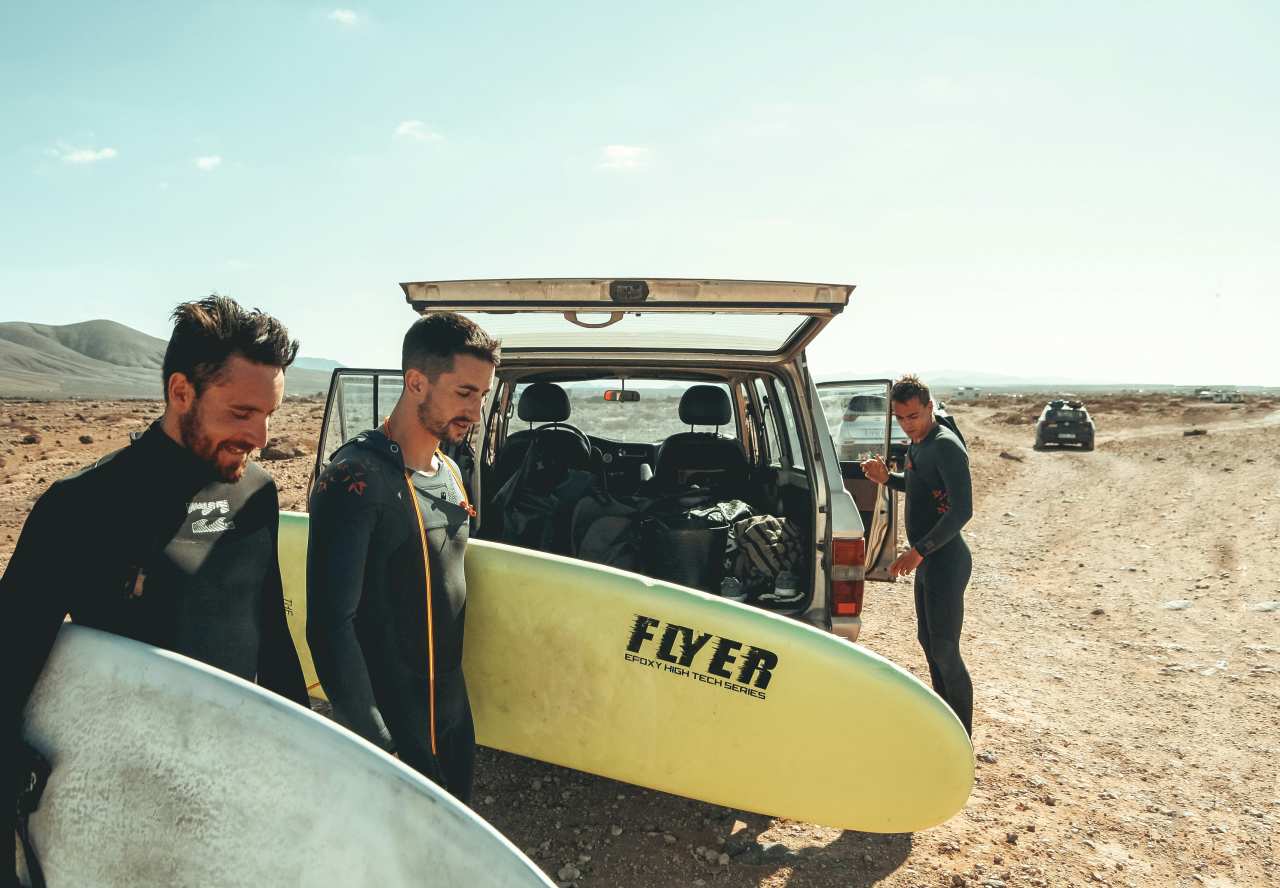The Toyota Prado has always been well regarded as a touring vehicle – seven seats, big driving range, as well as comfortable and capable on-road and off – but in recent years it has faced stiff competition in the form of the Ford Everest, Isuzu MU-X, Mitsubishi Pajero and others of that ilk.
And now, if you’re keen for the next-gen Prado then you’d better excel at being patient because that new version is not likely to lob here until 2023 or even later.
Until then, you could perhaps satisfy your Prado itch with a top-spec Kakadu sporting an optional flat tailgate (i.e. full-sized spare tyre moved from the rear to the underbody). But is it good enough to warrant a near $90,000 price-tag?
Read on.
Toyota Landcruiser Prado 2022: Kakadu
| Engine Type | Diesel Turbo 4, 2.8L |
|---|---|
| Fuel Type | Diesel |
| Fuel Efficiency | 7.9L/100km (combined) |
| Seating | 7 |
| Price From | $80,410 - $92,400 |
| Safety Rating |
|
Does it represent good value for the price? What features does it come with?
The Prado Kakadu is a seven-seat 4WD wagon with a price as listed of $87,807, excluding on-road costs. Price as tested is $88,482, because our test vehicle was wearing the $675 premium paint job (Dusty Bronze).
Among its more notable standard features are a premium woodgrain-look power-adjustable steering wheel with paddle shifters, leather-accented, heated and ventilated front seats, dual-range 4WD, as well as 4WDing-suitable driver-assist systems, such as crawl control and multi-terrain select (both for off-roading), adaptive variable suspension (with three modes: comfort, normal and sport), rear air suspension and Toyota’s Kinetic Dynamic Suspension System (KDSS).

It also has a 9.0-inch touchscreen multimedia unit with Apple CarPlay, Android Auto and sat-nav, 19-inch ‘Prestige design’ alloy wheels (part of the most recent range refresh), three-zone climate control air conditioning, panoramic-view monitor, tilt-and-slide moonroof, Toyota Safety Sense (including Pre-Collision Safety System with Pedestrian Detection, High Speed Active Cruise Control, and more), JBL 14-speaker sound system, a rear-seat entertainment system (Blu-ray DVD player) with 9.0-inch screen and three wireless headsets, and button-operated third-row power-folding seats.

A flat tailgate pack (which moves the full-size spare wheel from the rear door to the Prado’s underbody) is available for the Kakadu. Our test vehicle had it. (Note: choosing this option reduces your fuel capacity from 150 litres to 87 litres, because you sacrifice the 63-litre sub tank so the spare tyre can be fitted underneath the vehicle.)
Kakadu interior seat trim choices are ether beige leather accented or black leather accented.
Exterior paint choices include Graphite, Espresso Brown, Glacier White, Crystal Pearl, Silver Pearl, Peacock Black, Eclipse Black, Ebony, Wildfire and Dusty Bronze (on our test vehicle).

There are plenty of accessories available for the Prado, but there are also bundled packs which incorporate several accessories in each pack to suit your lifestyle: the Adventure Pack includes an alloy bull bar (commercial), light bar (fitting kit sold separately), snorkel, roof rack with alloy roof tray (both sold separately), weather-shields (left and right sold separately); and the Weekend Getaways pack, which includes a nudge bar (black), light bar (fitting kit sold separately), bonnet protector (tinted), roof racks with bike carrier (both sold separately), tow bar, tow ball and trailer wiring harness.
Is there anything interesting about its design?
The flat tailgate Kakadu is 4825mm long (4995mm with tyre mounted on the tailgate), 1885mm wide, 1880mm high, and it has a kerb weight of 2290kg (2350kg for ‘normal’ Prado).
The flat tailgate pack (which moves the full-size spare wheel from the rear door to the Prado’s underbody) cuts the Prado’s fuel capacity from 150 litres to 87 litres, because you sacrifice the 63-litre sub tank so the spare tyre can be fitted underneath the vehicle. This reduction in fuel capacity results in a substantial drop in driving range and so it’ll factor heavily in the buying decision, especially if the potential owner is keen on off-road touring.

The current design is less blocky than that of previous iterations but it retains a recognisable Prado bulk about it. If you like your SUVs even more streamlined then you’ll have to wait until the next-generation Prado arrives.

What are the key stats for the engine and transmission?
The Kakadu has a 2.8-litre four-cylinder turbo-diesel engine – producing 150kW at 3000-3400rpm and 500Nm at 1600-2800rpm – and that’s matched with a six-speed automatic transmission.
This is a solid combination, but one lacking any dynamic edge, which is fine with me because this pairing yields a drive experience that’s equal parts relaxed, assured and undemanding.

The Prado has a full-time four-wheel drive system with high- and low-range.
Note: the Prado has a diesel particulate filter (DPF) and issues linked to those systems have been well documented, so head to our Toyota Prado problems page to stay up to date with any DPF details.
How practical is the space inside?
There’s something comfortingly familiar about the interior of a Prado – some might prefer to use the descriptors ‘old’, ‘dated’ or ‘tired’ – but I like it. The cabin is instantly home and especially in this top-shelf guise, it is plush and very comfortable.
Though the Kakadu’s entire cabin is pretty well-presented and -equipped, of course those upfront get the best deal of all. The front seats in the Kakadu are heated, ventilated and power-adjustable and the driver and front passenger have ready access to the multimedia system, which is easy enough to operate and we hooked up an iPhone without too much fuss, as well as the usual complement of cupholders (two in front of the centre console) and USB charge points within reaching distance, as well as the refrigerated cool box that replaces the usual centre console.

The Kakadu has three-zone climate control so everyone has a hand in how toasty or chilled they are during any journey.
Floor mats in the Kakadu are carpet, not the all-weather rubber mats that you get in lower-spec Prados.

The second-row is a 40/20/40 sliding split and the outer seats are heated. Second-row passengers get directional air vents, fan and temp controls, seat-heating controls, 12V point (all in the rear of the centre console), and a fold-down centre arm-rest with built-in dual cupholder.
The second-row seats have three top-tether points and two ISOFIX locations.
There are mesh map pockets on the driver and front passenger seat-backs.

The third-row seats – set up in a 50/50 split fold-flat configuration – are button-operated and power-folding. Passengers have a cupholder each, as well as air vents and a speaker mounted nearby. They also have a clear view of the 9.0-inch ceiling-mounted DVD screen – yep, DVDs. Old school. There are only three wireless headsets provided so parents prepare for arguments if you have more than a trio of kids in your Prado.
With the third-row seats in use, boot space is listed as 104 litres.

If not in use, the rear-most seats can be power-folded away at the press of a button and the area used for luggage, concealed by a retractable cargo blind. With the third row stowed away, there’s a claimed (combined) 553 litres of cargo space.
With the second and third rows folded down and out of the way, there’s a claimed 974 litres available.
All in all, the Kakadu’s cabin is quite a practical space, but with a healthy dose of premium about it.
What's it like as a daily driver?
The Prado is an easy-driving 4WD wagon with plenty to like about living with it day to day. And the Kakadu is simply the plushest of the lot.
It’s very comfortable – its seats are on the right side of cushy – and premium materials and soft-touch surfaces make long road trips in the cabin more an appealing proposition than an annoying one.

But one of the Kakadu’s major points of difference with lower-grade Prados is that it is equipped as standard with Toyota’s Kinetic Dynamic Suspension System (KDSS) and this makes a substantial contribution to ironing out any ride and handling irregularities, with KDSS performing as an active swaybar system.
In very basic terms, KDSS hydraulically alters tension on the sway bars to suit the terrain – so it tightens them for reduced body roll and more dynamic handling on-road, and loosens them for greater wheel travel in order to further improve performance off-road – but more about that later.

Also aimed at further bolstering the Kakadu in terms of comfort, handling and stability is its adaptive variable suspension which can be set to one of three modes (comfort, normal or sport) via an in-cabin switch and that helps the driver to dial-in smooth and well-sorted ride and handling; and its height-adjustable rear air suspension with switchable low, normal or high modes.
Adding to the Prado’s cocooned cabin feel is the fact it’s very quiet inside – with most of any external noise muffled to a subdued hum.
Steering is better in the Prado than it has been in the past with a nicer weight about it, although it can still tend to feel a bit floaty if you’re used to a more tightly controlled vehicle. It’s handy that the driver can really dial-in their position as the steering wheel is electric tilt-and-telescopic adjustable.
The Kakadu, with a 11.6m turning circle, also feels pretty nimble around parked-in streets and busy regional centres, as well as on tight bush tracks – but more about that later.
As for the 2.8 litre turbo-diesel engine and transmission pairing – well, it’s an unhurried, almost sluggish combination, but one that I have a lot of time for because it yields a relaxed drive experience rather than a pulse-pounding one.

Having said that, acceleration is gutsy enough to punch the Prado off the mark and also get it moving at pace to overtake when needed.
The characteristics detailed above are all well and good but perhaps the upcoming Ford Everest’s 3.0-litre V6 turbo-diesel engine – with a suspected torque output of close to 600Nm – will rattle the Prado’s cage in terms of performance appeal. And the next-gen Everest’s 3500kg towing capacity won’t hurt its efforts to laud it over the Prado either.
Anyway, back to the Kakadu.
Brakes – ventilated discs at each corner – proved to be as sound as a pound and were able to bring the Prado to a rapid stop every time I stomped them into submission during my patented ‘Watch out for that kangaroo!” emergency-braking tests on dry and wet bitumen. Not bad for a 4WD wagon tickling the 2.3 tonne mark.
The Kakadu’s Dunlop Grandtrek AT30 tyres (265/55 R19) are well-suited to on-road driving but that’s because they are compromised in favour of the blacktop and for all-terrain rubber they fall a tad short when it comes to 4WDing – but, you guessed it, more about that later. (Well, actually, just below, in the next section.)
What's it like for touring?
It should come as no surprise that the Kakadu is nice to drive off-road – it’s comfortable and very capable. It’s a nice blend of traditional-style 4WD mechanicals, ample low-down torque and a quietly effective and comprehensive suite of driver-assist tech aimed at maximising performance on rough terrain.
On the loosely gravelled soggy track that leads the way to our 4WD testing and proving ground, the route was peppered with extra-greasy mud patches due to recent rain and gouged by deep ruts and severe-sided mudholes at irregular intervals. No matter, because the Kakadu managed it all supremely well.
And a lot – if not most – of the credit of that controlled ride and handling is due to the Kakadu’s KDSS, operating at full strength, loosening swaybars to suit the terrain, allowing axles full-stretch articulation where needed. And that’s very handy at low speeds when sustaining safe and controlled momentum via maximised traction is the goal.

And this became even more obvious when we tackled some of our set-piece rocky hill-climbs, the approaches to which were even more pitted, rutted and treacherous than usual due to overnight heavy rain.
The Kakadu trucked over the undulating ground quietly, no fuss, at low revs and with wheels dipping and rising as they stuck steadfastly to the dirt. Wheel travel in a standard Prado is fine but the KDSS-equipped Kakadu just seems to get even more flex on the move.
It conquered everything with impressive ease, only ever scrambling momentarily for grip because of its tyres – swap those with a decent set of all-terrains and you’d instantly make a great off-roader even better.
Steering retains a nice balance to it at low speeds, throttle response is good (not touchy over lumps and bumps), the driver enjoys plenty of visibility (crucial for low-range highly technical 4WDing that relies so heavily on choosing the correct line up and down a rocky hill, through a tight track etc), and the Kakadu’s dimensions offer off-road angles* that are good for a cityfied SUV wagon. (*If you’re interested: the approach angle is listed as 30.4 degrees, ramp-over is 21.2 and departure is 23.5.)

But these are all characteristics of even lower-spec Prados, such as the GX or GXL.
Yep, the Kakadu has a near-overwhelming raft of driver-assist tech – not the least of which is crawl control (a low-speed low-range cruise control/traction control on steroids, if you will, with five selectable speeds), and Multi-Terrain Select (with off-road driving modes that adjust steering, throttle and traction control to suit the terrain you’re on, e.g. rock and dirt, mud and sand etc) but, more importantly, it has plenty of torque across a wide rev range, and front, centre and rear locking differentials.
Towing capacity is 750kg (unbraked) and 3000kg (braked), which may prove an irksome figure to more than a few potential buyers because, well, it’s not that seemingly magical (misleading?) figure of 3.5 tonnes that buyers get so excited about, is it? Also, the next-gen 3.0-litre V6 turbo-diesel Ford Everest will have a 3500kg towing capacity – as well as that engine – so there’s that.
The Kakadu has a gross vehicle mass (GVM) of 2990kg and a GCM (gross combined mass) of 5990kg.

Our test vehicle had the no-cost flat tailgate pack, which moves the spare tyre from the rear door to the underbody – that allows you, among other things, a bit more easy access to the rear cargo area via the glass hatch/window. There is a trade-off though – by moving the spare tyre to the undercarriage, you lose the 63-litre sub tank, reducing your total fuel capacity from 150 litres to 87 litres and that ultimately reduces your driving range. Don’t say I didn’t warn you.
As a Prado, it’s as reliably effective off-road as always, without ever looking as full-blown macho as something like the 70 Series, or even a 200 Series, and it still makes a very appealing platform as a touring vehicle. But this flat-tailgate Kakadu, minus the extra fuel capacity of a Prado with the tailgate-mounted spare, loses a chunk of appeal as a tourer due to that fact.
How much fuel does it consume?
The Prado has an offical fuel consumption of 7.9L/100km (on a combined cycle).
We recorded 13.5L/100km on test, but we clocked up a lot of high- and low-range 4WDing.
This Prado has 87L fuel tank capacity – that’s 63 litres less than any Prado that does not have the flat tailgate* – and our on-test fuel-consumption figure would give us an effective touring range of about 644km, which includes a safe-distance buffer of about 50km.
(* I know I’m at risk of belabouring the point at this stage after issuing repeated warnings in this yarn, but … if you’re planning to use your Prado as a touring vehicle, worth noting here is the fact that by opting for the flat tailgate pack, which moves the full-size spare wheel from the rear door to the Prado’s underbody, you’ve reduced this vehicle’s fuel capacity from 150 litres to 87 litres, because you sacrifice the 63-litre sub tank so the spare tyre can be fitted underneath the vehicle. Case in point: if we’d had 150-litre fuel capacity on this test we could have had a potential driving range of about 1050km.)
Warranty & Safety Rating
What safety equipment is fitted? What safety rating?
The Prado has the maximum five-star ANCAP safety rating from 2011, but that rating expires at the end of 2022 and Toyota has no plans to re-test this generation. As mentioned earlier, the new Prado is not expected here until 2023 or even 2024.
The second-row seats have three top-tether points and two ISOFIX locations.
The current Prado has seven airbags, three top-tether points and two ISOFIX locations in the second row, and is stacked with driver-assist tech including pre-collision avoidance with autonomous emergency braking, high-speed active cruise control, lane-departure alert with steering assistance, automatic high beam, road sign assist and more.
What does it cost to own? What warranty is offered?
The Prado has a five-year/unlimited kilometre warranty.
Maintenance is scheduled for every six months or 10,000km, whichever comes first.
Every new Prado comes with capped price servicing of $260 per service up to the three-year mark.
Verdict
The Prado is an appealing daily driver and touring vehicle, even minus a lot, if not most, of the top-spec Kakadu’s tech wizardry, leather accents, moon-roof and even its cooler box.
Do you really need any of those things? No. But do you want them? Yep, especially if a premium-style brew is your cup of tea.
But I’d be inclined to opt for a lower-spec Prado, a GXL or even a GX. Sure, you miss out on a few nice Kakadu features – such as KDSS and multi-terrain select – but the Prado is, by its very nature, a functional and comfortable daily driver and a very capable 4WD tourer as is, so you’re not sacrificing any of that by choosing a cheaper variant. Bonus: use the money you save by not buying a Kakadu to get your hands on plenty of aftermarket gear for your new adventure machine.
Pricing Guides

Range and Specs
| Vehicle | Specs | Price* |
|---|---|---|
| GX | 2.8L, Diesel, 6 SPEED AUTOMATIC | $64,460 - $74,030 |
| GX 7 Seat | 2.8L, Diesel, 6 SPEED AUTOMATIC | $60,060 - $69,080 |
| GXL | 2.8L, Diesel, 6 SPEED AUTOMATIC | $63,910 - $73,480 |









.jpg)
.jpg)










.jpg)
.jpg)
.jpg)
.jpg)
.jpeg)

.jpg)
.jpg)



.jpg)
Comments